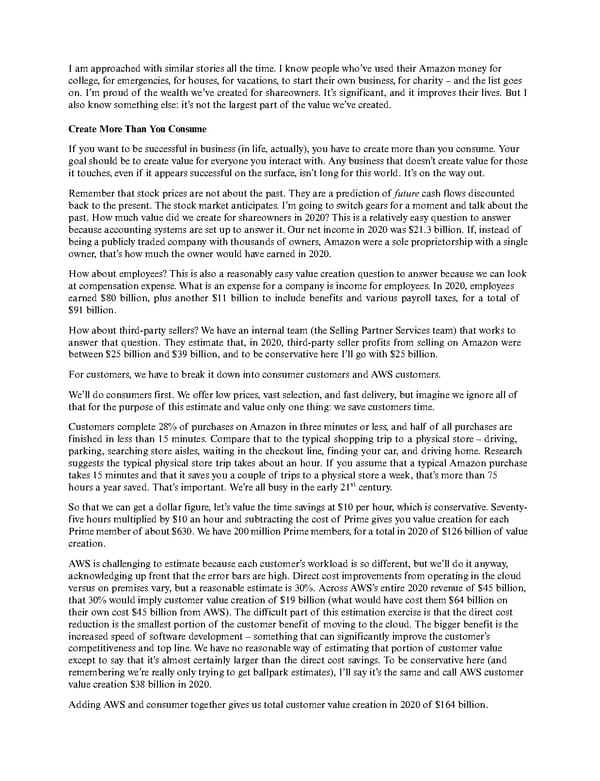I am approached with similar stories all the time. I know people who’ve used their Amazon money for college, for emergencies, for houses, for vacations, to start their own business, for charity – and the list goes on. I’m proud of the wealth we’ve created for shareowners. It’s significant, and it improves their lives. But I also know something else: it’s not the largest part of the value we’ve created. Create More Than You Consume If you want to be successful in business (in life, actually), you have to create more than you consume. Your goal should be to create value for everyone you interact with. Any business that doesn’t create value for those it touches, even if it appears successful on the surface, isn’t long for this world. It’s on the way out. Rememberthatstockpricesarenotaboutthepast.Theyareapredictionof futurecashflowsdiscounted backtothepresent.Thestockmarketanticipates.I’mgoingtoswitchgearsforamomentandtalkaboutthe past. How much value did we create for shareowners in 2020? This is a relatively easy question to answer because accounting systems are set up to answer it. Our net income in 2020 was $21.3 billion. If, instead of beingapubliclytradedcompanywiththousandsof owners,Amazonwereasoleproprietorshipwithasingle owner, that’s how much the owner would have earned in 2020. Howaboutemployees?Thisisalsoareasonablyeasyvaluecreationquestiontoanswerbecausewecanlook at compensation expense. What is an expense for a company is income for employees. In 2020, employees earned $80 billion, plus another $11 billion to include benefits and various payroll taxes, for a total of $91billion. Howaboutthird-partysellers? We have an internal team (the Selling Partner Services team) that works to answer that question. They estimate that, in 2020, third-party seller profits from selling on Amazon were between $25 billion and $39 billion, and to be conservative here I’ll go with $25 billion. Forcustomers, we have to break it down into consumer customers and AWS customers. We’ll do consumers first. We offer low prices, vast selection, and fast delivery, but imagine we ignore all of that for the purpose of this estimate and value only one thing: we save customers time. Customerscomplete28%of purchasesonAmazoninthreeminutesorless,andhalf of allpurchasesare finished in less than 15 minutes. Compare that to the typical shopping trip to a physical store – driving, parking, searching store aisles, waiting in the checkout line, finding your car, and driving home. Research suggests the typical physical store trip takes about an hour. If you assume that a typical Amazon purchase takes 15 minutes and that it saves you a couple of trips to a physical store a week, that’s more than 75 hours a year saved. That’s important. We’re all busy in the early 21st century. Sothatwecangetadollarfigure,let’s value the time savings at $10 per hour, which is conservative. Seventy- five hours multiplied by $10 an hour and subtracting the cost of Prime gives you value creation for each Primememberof about$630.Wehave200millionPrimemembers,foratotalin2020of $126billionof value creation. AWSischallengingtoestimatebecauseeachcustomer’s workload is so different, but we’ll do it anyway, acknowledging up front that the error bars are high. Direct cost improvements from operating in the cloud versus on premises vary, but a reasonable estimate is 30%. Across AWS’s entire 2020 revenue of $45 billion, that 30% would imply customer value creation of $19 billion (what would have cost them $64 billion on their own cost $45 billion from AWS). The difficult part of this estimation exercise is that the direct cost reduction is the smallest portion of the customer benefit of moving to the cloud. The bigger benefit is the increased speed of software development – something that can significantly improve the customer’s competitiveness and top line. We have no reasonable way of estimating that portion of customer value except to say that it’s almost certainly larger than the direct cost savings. To be conservative here (and rememberingwe’re really only trying to get ballpark estimates), I’ll say it’s the same and call AWS customer value creation $38 billion in 2020. AddingAWSandconsumertogethergivesustotalcustomervaluecreationin2020of $164billion.
 Amazon Shareholder Letters 1997-2020 Page 106 Page 108
Amazon Shareholder Letters 1997-2020 Page 106 Page 108